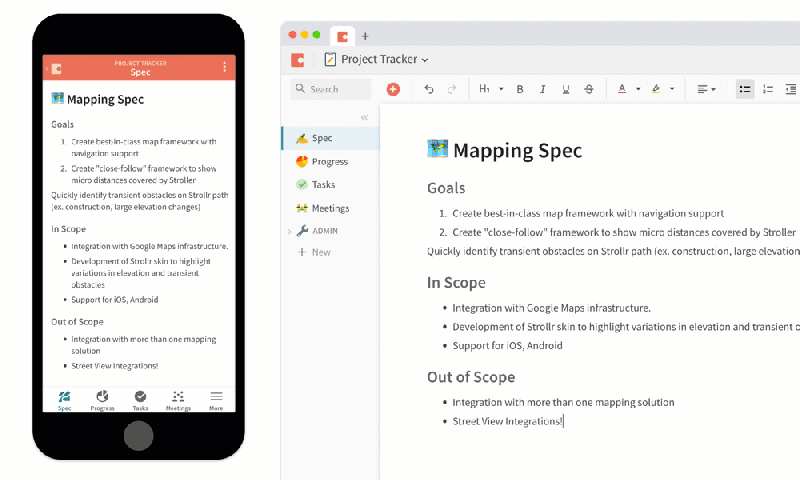Coda, a workplace automation and organization platform five years in the making, at long last made its public debut today, after months in private beta and financing rounds totaling $60 million from Greylock, General Catalyst Partners, Khosla Ventures, NEA & KCPB, LinkedIn cofounder and former CEO (and Coda board member) Reid Hoffman, and other angel investors.
It’s the brainchild of Microsoft and YouTube alumni Alex DeNeui and Shishir Mehrotra, who met at the Massachusetts Institute of Technology as undergraduates. Distilled to its basics, Coda is a kind of canvas that blends spreadsheets, presentations, apps, and documents in one. A one-tap presentation mode lets you view any doc in full-screen, like a PowerPoint. And a powerful programming language allows you to quickly embed tables and graphs, or elements like calendars, buttons, and sliders.
“Coda started when we asked ourselves: In a world full of applications, why do documents and spreadsheets still run everything? Why haven’t they changed in over 40 years? And what would we build if we started from scratch?” Mehrotra wrote in a blog post. “What started as a small group of beta-testers quickly grew to tens of thousands of people, from all over the world, representing different job titles, backgrounds, and use cases.”

June 5th: The AI Audit in NYC
Join us next week in NYC to engage with top executive leaders, delving into strategies for auditing AI models to ensure fairness, optimal performance, and ethical compliance across diverse organizations. Secure your attendance for this exclusive invite-only event.
It’s been gaining functionality at a steady clip, such as Coda Packs, which act as a bridge between Coda and external tools like Gmail, Greenhouse, Intercom, Figma, Walmart Shopping, and GitHub, to name a few. Packs can pull in Instagram images, YouTube videos, data about stocks and weather, and other media, or perform tasks and push information out to apps like Slack and Twilio. Automations — a newer feature — enables time-saving contextual triggers that modify rows, tables, and more within (and outside of) Coda.
So what’s new in Coda 1.0? The doc interface has a fresh coat of paint. A blank canvas with a blinking cursor takes up a good portion of the screen, but there’s a persistent left-hand menu carved out for sections and folders. Tables have been reworked, too — they act as databases, ranging in complexity from simple color-coded lists to complex models. Coda’s enhanced views tool enables individual authors to filter out table data that isn’t relevant to them, and to reorder tables to their liking — as calendars, for example, or in kanban layouts.
That’s not all that’s improved. The revamped Coda app for iOS features a modular design that “automatically transforms” docs so that they appear — and behave — as they would in a native flow. Sections become bottom tabs; tables and buttons shrink; and notifications set up in docs are pushed as toast messages.

“We designed Coda for all the people who, despite the apps they buy, spend their days in documents and spreadsheets. They are the organizers, the toolmakers, the problem-solvers — the people who don’t wait for the marketplace to hand them a solution, and instead build it for themselves,” Mehrotra said.
Competitors abound in Coda’s market, of course — Quickbase, Zapier, IFTTT, and Airtable come to mind, the latter of which closed a $100 million funding round last year. To Coda’s credit, though, it’s gained plenty of traction in just a few short years. A team at Uber used it to track a major redesign, and a product manager at Spotify — Tracy Chan — created a Coda tool to help organize team tasks. And a group within New York media company Cheddar taps Coda to notify team members when assigned articles changed hands in the editorial process.
“At Spotify, teams are empowered to use whatever tools work best for them, which can sometimes create challenges with cross-functional collaboration,” Chan said. “[Coda] kills two birds with one stone — teams can customize views that work for their team while keeping all information consistently updated in one central place … What’s cool too is that you end up building an app, specifically made for your team, without even realizing it.”

Time will tell whether Coda’s able to gain traction in the overcrowded enterprise collaboration sector — a sector that’s forecast to be worth $49.51 billion by 2021. But Mehrotra is confident it’s well-positioned to make a dent.
